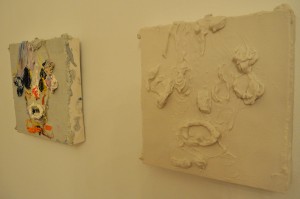Is This Copyright Infringement of an Artist’s Painting?
I don’t think so, but see what you think. My good friend, and fellow artist-lawyer, Alfred Steiner, has taken it upon himself to dabble in some potential legal trouble. You see, Steiner
…bought a glob-erific clown painting by Allison Schulnik at Canada gallery on the Lower East Side. He then proceeded to have a replica of the work fabricated on a ZPrinter 650 3D printer. The result is a quite good monochromatic reproduction of the painting that is full of the brushstrokes and textures that until recently we thought we couldn’t so easily reproduce.
Steiner, having quite a bit of experience in copyright law, contacted Schulnik and alerted her to his alleged infringement. But is what Steiner did actually copyright infringement? At this late hour (11:00pm EST), I would have to say, not at all.
You see, one great aspect of painting is the use/non-use of color paint. In this case, to make a monochrome painting copy of an impastoed/expressionistic painting is synonymous to making a black version of a Robert Ryman or a pink version of a gray Gerhard Richter. At that point, one can easily concede that the copy is based more on inspiration than on infringement, regardless of the clown face on Schulnik’s painting. Schulnik’s clown face, one can certainly argue, is a generic representation of a clown face. To say that Steiner’s white version is a derivative work, and therefore infringing on Schulnik’s painting, would be tantamount to saying that no other artist could paint a clown face impasto-style, white or in color. Silly indeed.
But, and as my fourth-grade teacher, Mrs. Cabbines, used to remark, “and this is a big but,” the real question is whether the mechanical reproduction of Schulnik’s painting is in fact infringement, where the copyright protection rests also on the sculptural aspects of Schulnik’s work. In this case, now we’re talking. And, I might add, the legal question gets more interesting (and juicier) if we ask how exactly Steiner went about copying Schulnik’s work. Why? Because if there is any, and by this I mean any, detrimental physical impact on Schulnik’s work, Steiner may just have triggered the Visual Artists Rights Act of 1990, which protects an artist’s painting (among a few other types of fine art) from distortion, modification, or destruction.
Until we know the exact process Steiner used to copy Schulnik’s work, we won’t know whether or not Schulnik’s moral rights to her painting were violated.
A great art project indeed!
More on this via Hyperallergic.
Tags: 3D modeling, alfred steiner, appropriation, Art Law, derivative work, fair use, intellectual property, painting




Question: why is this different than Jeff Koons’ appropriation of a b&w photo of puppies and transforming it into a sculpture? That, of course, was not deemed sufficiently transformative to constitute fair use. In other words, one could say that merely translating a work into another medium is not sufficiently transformative. But don’t get me wrong. I think that construing fair use this narrowly is not appropriate.